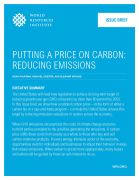Putting a price on carbon: reducing emissions
 The United States will need new legislation to achieve its long-term target of reducing greenhouse gas (GHG) emissions by more than 80 percent by 2050. In this issue brief, show how a national carbon price—in the form of either a carbon tax or a cap-and-trade program—can help the United States achieve this target by inducing emissions reductions in sectors across the economy. When GHG emissions are unpriced, the costs of climate change are borne by third parties unrelated to the activities generating the emissions. A carbon price shifts these costs from society as a whole to those who buy and sell carbon-intensive products. In every energy-intensive sector of the economy, opportunities exist for individuals and businesses to adjust their behavior in ways that reduce emissions. When carbon is priced more appropriately, many buyers and sellers will be guided by financial self-interest to do so.
The United States will need new legislation to achieve its long-term target of reducing greenhouse gas (GHG) emissions by more than 80 percent by 2050. In this issue brief, show how a national carbon price—in the form of either a carbon tax or a cap-and-trade program—can help the United States achieve this target by inducing emissions reductions in sectors across the economy. When GHG emissions are unpriced, the costs of climate change are borne by third parties unrelated to the activities generating the emissions. A carbon price shifts these costs from society as a whole to those who buy and sell carbon-intensive products. In every energy-intensive sector of the economy, opportunities exist for individuals and businesses to adjust their behavior in ways that reduce emissions. When carbon is priced more appropriately, many buyers and sellers will be guided by financial self-interest to do so.
Related Content
- Air pollution and climate change: from co-benefits to coherent policies
- Enhancing carbon pricing and international carbon market readiness through the mitigation action assessment protocol: summary report
- India Inc increases focus on reducing carbon emission: CDP
- Energy efficiency market report 2016
- Re-powering markets: market design and regulation during the transition to low-carbon power systems
